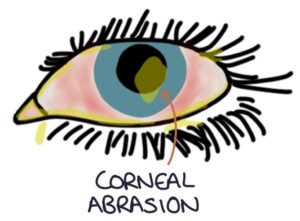Corneal abrasions are scratches or damage to the cornea. They cause a red, painful eye and photophobia.
Common causes include:
- Damaged contact lenses
- Fingernails
- Foreign bodies (e.g., metal fragments)
- Tree branches
- Makeup brushes
- Entropion (inward turning eyelid)
Chemical abrasions (e.g., from acid) can cause severe damage and vision loss, requiring immediate extensive irrigation and ophthalmology input.
Abrasions associated with contact lenses may be associated with Pseudomonas infection. An important differential is herpes keratitis, which requires antiviral treatment.
Presentation
There is often a history of trauma, followed by:
- Painful red eye
- Photophobia
- Foreign body sensation
- Epiphora (excessive tear production)
- Blurred vision
A fluorescein stain can be applied to the eye to help diagnose a corneal abrasion. This is a yellow-orange colour and collects in abrasions or ulcers, highlighting them, particularly when viewed under cobalt blue light.

Management
Mild, uncomplicated abrasions may be managed in primary care where there is appropriate experience and skill. Uncomplicated corneal abrasions usually heal over 2-3 days. More complicated cases require assessment and management by ophthalmology.
Management options include:
- Removing foreign bodies
- Simple analgesia (e.g., paracetamol)
- Lubricating eye drops
- Antibiotic eye drops (e.g., chloramphenicol)
- Close follow-up
Lubricating eye drops vary in their viscosity:
- Hypromellose drops are the least viscous (the effects last around 10 minutes)
- Polyvinyl alcohol drops are the middle viscous choice
- Carbomer drops are the most viscous (the effects last about 30-60 minutes)
Last updated October 2023
